The Hortus Conclusus (Enclosed Garden)
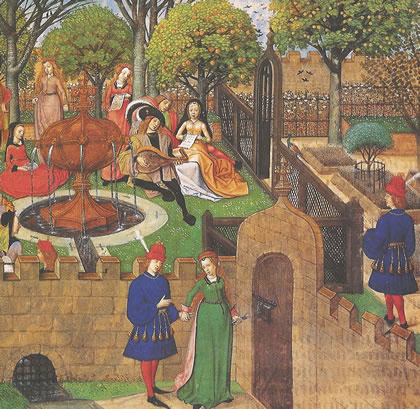
Flemish illustration of the Romance of the Rose c. 1485
Small medieval gardens, or herbers, were generally square or rectangular and surrounded by hedges or walls. Often divided into four equal sections, these gardens featured a fountain or basin in the center and beds or containers of herbs, flowers, roses, and small trees. The garden features other elements typical of the medieval herber or herbarium (a place of refreshment where decorative and useful plants were grown): a tunnel arbor, a garden enclosed with shrubs (or a fence or wall), geometrically laid out beds, a lawn, fruit trees, a water feature (dry or wet), a gravel walk way, and edible and decorative plants mixed together. Fragrant flowers and foliage were greatly valued in the middle ages.
Symbolism of the Garden
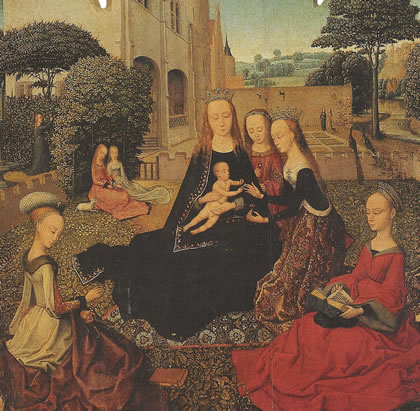
Madonna and child in garden, c. 1490
Gardens in the middle ages were strongly imbued with religious symbolism. The Old Testament Song of Songs mentions several types of gardens and flowers. Medieval commentators interpreted this ancient erotic love song to be an allegory of the Virgin Mary, the sealed garden into which the Holy Spirit entered at the Annunciation.

Adoration of the Lamb, Ghent Altarpiece, St. Bavo Church, Ghent, 1425-29
Gardens also symbolized the paradise of Eden, which contained “every kind of tree, enticing to look at and good to eat,” planted by God Himself. (Gen. 2:8-9) The celestial paradise awaiting the faithful after death also contained a garden: in the walled city of the Heavenly Jerusalem “on either side of the river were the trees of life, which bear twelve crops of fruit in a year, one in each month, and the leaves of which are the cure for the pagans.” (Apoc. 22:1-2)
The Garden of the Philosophers
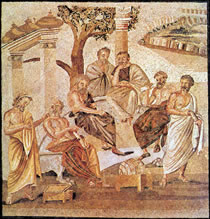
Roman Mosaic of Plato's Academy, Pompei
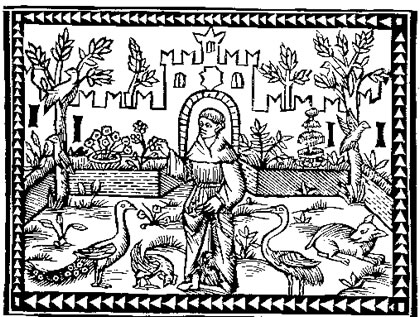
Engraving of monk in garden
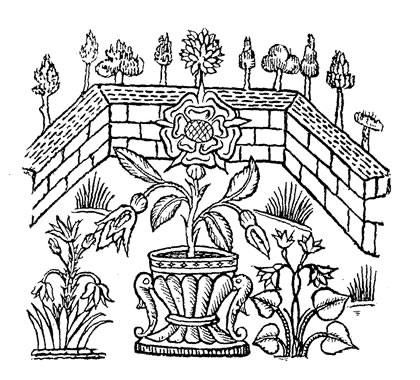
Gardens have been associated with philosophers since the time of ancient Athens; and monks and scholars would keep this connection alive until the emergence of the Renaissance. Plato was famous for having taught in the groves of the Academy under a colonnaded palaestra in Athens.
Even after his conversion to Christianity St. Augustine continued this philosophical tradition, meeting with his fellow monks in a garden given to him by his friend Valerius. St. Benedict, the father of Western monasticism, planted a rose garden at his early monastery in Subiaco near Rome (c. 500). The two major medieval works on garden design and horticulture were by the Benedictine monk Walafrid Strabo (c. 850) and the Dominican friar Albert the Great (c.1250). Medieval universities valued outdoor places–scholars of Paris had the field of St. Germaine for recreation in the 13th century; Oxford colleges had gardens.
The early Italian Renaissance humanists also turned to gardens. Boccaccio set his Decameron (c. 1350) in the garden of the Villa Palmieri. Boccaccio first met Petrarch at Petrarch’s garden in Milan in March 1359; to commemorate the event together they planted a bay tree. In the fifteenth century Cosimo de’Medici organized a new Platonic Academy at his villa in Careggi, and in the early sixteenth century a Roman academy met in the gardens of humanists in the Eternal City.
In time universities created botanical gardens of collections of plants connected to fields of study such as medical and apothecary programs. The earliest one known is the University of Padua’s Orto Botanico, founded in 1545. Oxford founded a university botanic garden in 1621.
This web site was written and designed by Nancy Lucid whose research was supported by a generous grant from the Bannan Institute for Jesuit Educational Mission at Santa Clara University.
For questions regarding the web site contact Nancy Lucid. All rights reserved.